Report on Supply Chain and Logistics Management in E-Commerce
VerifiedAdded on 2023/05/30
|14
|4808
|194
Report
AI Summary
This report provides a comprehensive analysis of supply chain and logistics management, specifically focusing on the challenges and solutions within the e-commerce sector. It begins by defining the supply chain and supply chain management, emphasizing their importance in transforming raw materials into finished products delivered to customers. The report then delves into various challenges faced by e-commerce businesses, including difficulties in global localization, customer retention, adapting to fast-changing markets, talent acquisition, ensuring quality and compliance, providing personalized customer experiences, adopting appropriate technology, managing cyber risks, and fostering supplier-partner relationships. For each challenge, the report offers potential solutions and strategies. The report concludes with recommendations to address these challenges and improve e-commerce supply chain efficiency. This report is valuable for students seeking to understand the complexities of modern e-commerce operations.

Running Head: SUPPLY CHAIN AND LOGISTICS MANAGEMENT
Supply Chain and Logistics Management
Supply Chain and Logistics Management
Paraphrase This Document
Need a fresh take? Get an instant paraphrase of this document with our AI Paraphraser
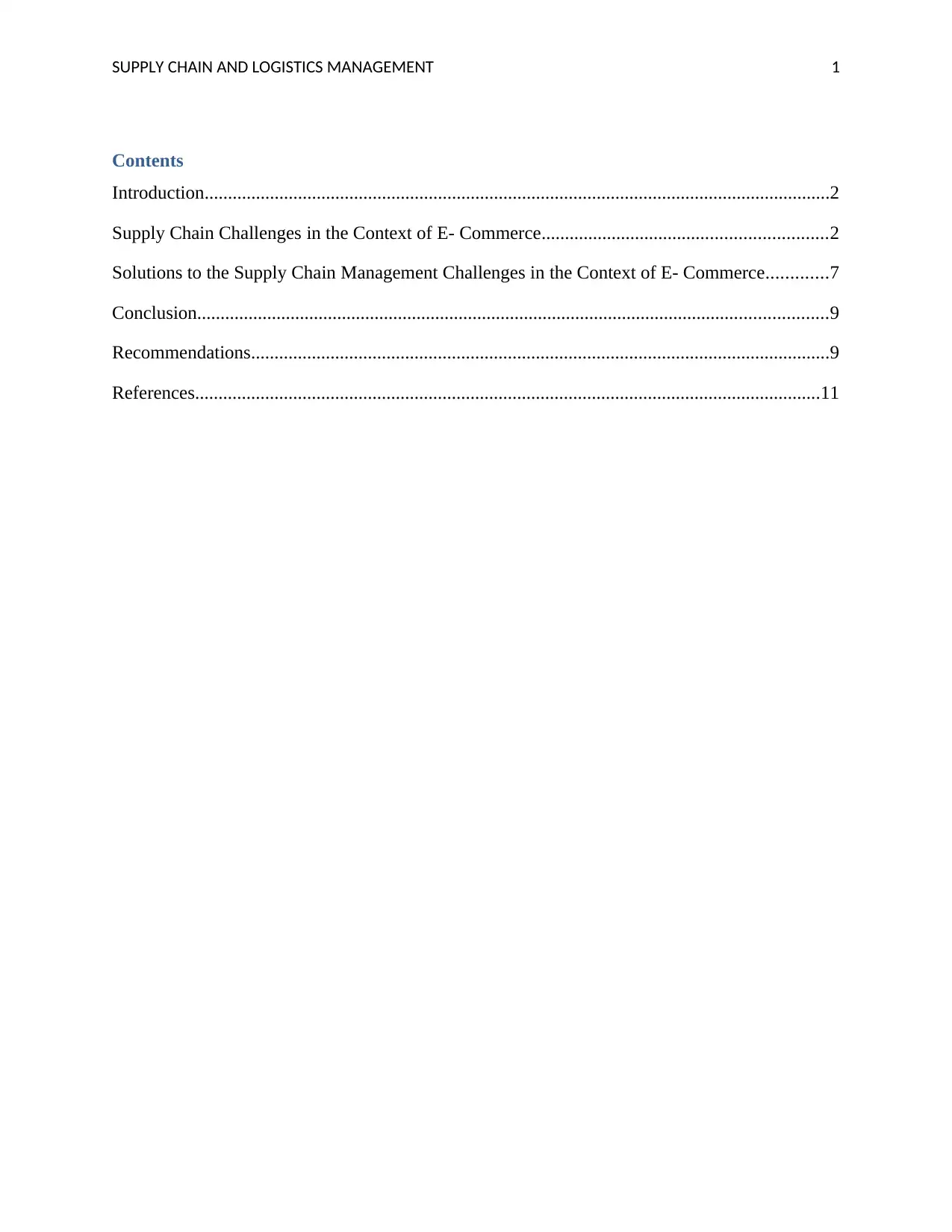
SUPPLY CHAIN AND LOGISTICS MANAGEMENT 1
Contents
Introduction......................................................................................................................................2
Supply Chain Challenges in the Context of E- Commerce.............................................................2
Solutions to the Supply Chain Management Challenges in the Context of E- Commerce.............7
Conclusion.......................................................................................................................................9
Recommendations............................................................................................................................9
References......................................................................................................................................11
Contents
Introduction......................................................................................................................................2
Supply Chain Challenges in the Context of E- Commerce.............................................................2
Solutions to the Supply Chain Management Challenges in the Context of E- Commerce.............7
Conclusion.......................................................................................................................................9
Recommendations............................................................................................................................9
References......................................................................................................................................11

SUPPLY CHAIN AND LOGISTICS MANAGEMENT 2
Introduction
A supply chain can be defined as a system of people, organizations, information, activities, and
resources which are involved in the process of transferring a product or service from supplier to
customer. These supply chain activities are involved in the task of transforming the raw
materials, natural resources and components into the finished product which is ultimately
delivered to the end user. The term supply chain management can be defined as the broad range
of activities which are needed for planning, controlling and executing the flow of a product from
acquiring raw materials to distribution of the product to final customer, in a most rationalized
and cost- effective way possible (Christopher, 2016). This report is focused on the supply chain
management challenges and solutions in the context of e- commerce. At the end of this report,
some recommendations have also been made which can be taken into consideration for the
purpose of tackling those challenges.
Supply Chain Challenges in the Context of E- Commerce
E- Commerce, also known as electronic commerce, can be regarded as the purchasing and sales
of products and services along with the transfer of data and money for the execution of these
transactions through the use of internet (Li, Chi, Hao and Yu, 2018). This term is often utilized
for the purpose of referring to the sale of physical products online or it can be described as the
commercial transaction which is facilitated through the use of internet. In case of e- commerce,
logistics also play a significant role. Logistics management is a part of supply chain management
and is a narrow concept. On the other hand, supply chain management is a broad concept.
Logistics ensure the management of products and resources at the time when they are storage
and transit. In the context of e- commerce ventures, logistics can be regarded as the processes of
transporting an inventory to a merchant or shipping order to the customers. A track of the goods
is kept by the logistics processes till the point of their delivery.
There are a number of supply chain challenges faced in the case of e- commerce.
Difficulty to Localize in the Global Economy- In the earlier days, the businesses used to target
only specific markets. Nowadays, the e- commerce companies possess the capability of quickly
expanding into new geographies with the help of their strong supply chain network. E-
Introduction
A supply chain can be defined as a system of people, organizations, information, activities, and
resources which are involved in the process of transferring a product or service from supplier to
customer. These supply chain activities are involved in the task of transforming the raw
materials, natural resources and components into the finished product which is ultimately
delivered to the end user. The term supply chain management can be defined as the broad range
of activities which are needed for planning, controlling and executing the flow of a product from
acquiring raw materials to distribution of the product to final customer, in a most rationalized
and cost- effective way possible (Christopher, 2016). This report is focused on the supply chain
management challenges and solutions in the context of e- commerce. At the end of this report,
some recommendations have also been made which can be taken into consideration for the
purpose of tackling those challenges.
Supply Chain Challenges in the Context of E- Commerce
E- Commerce, also known as electronic commerce, can be regarded as the purchasing and sales
of products and services along with the transfer of data and money for the execution of these
transactions through the use of internet (Li, Chi, Hao and Yu, 2018). This term is often utilized
for the purpose of referring to the sale of physical products online or it can be described as the
commercial transaction which is facilitated through the use of internet. In case of e- commerce,
logistics also play a significant role. Logistics management is a part of supply chain management
and is a narrow concept. On the other hand, supply chain management is a broad concept.
Logistics ensure the management of products and resources at the time when they are storage
and transit. In the context of e- commerce ventures, logistics can be regarded as the processes of
transporting an inventory to a merchant or shipping order to the customers. A track of the goods
is kept by the logistics processes till the point of their delivery.
There are a number of supply chain challenges faced in the case of e- commerce.
Difficulty to Localize in the Global Economy- In the earlier days, the businesses used to target
only specific markets. Nowadays, the e- commerce companies possess the capability of quickly
expanding into new geographies with the help of their strong supply chain network. E-
⊘ This is a preview!⊘
Do you want full access?
Subscribe today to unlock all pages.

Trusted by 1+ million students worldwide
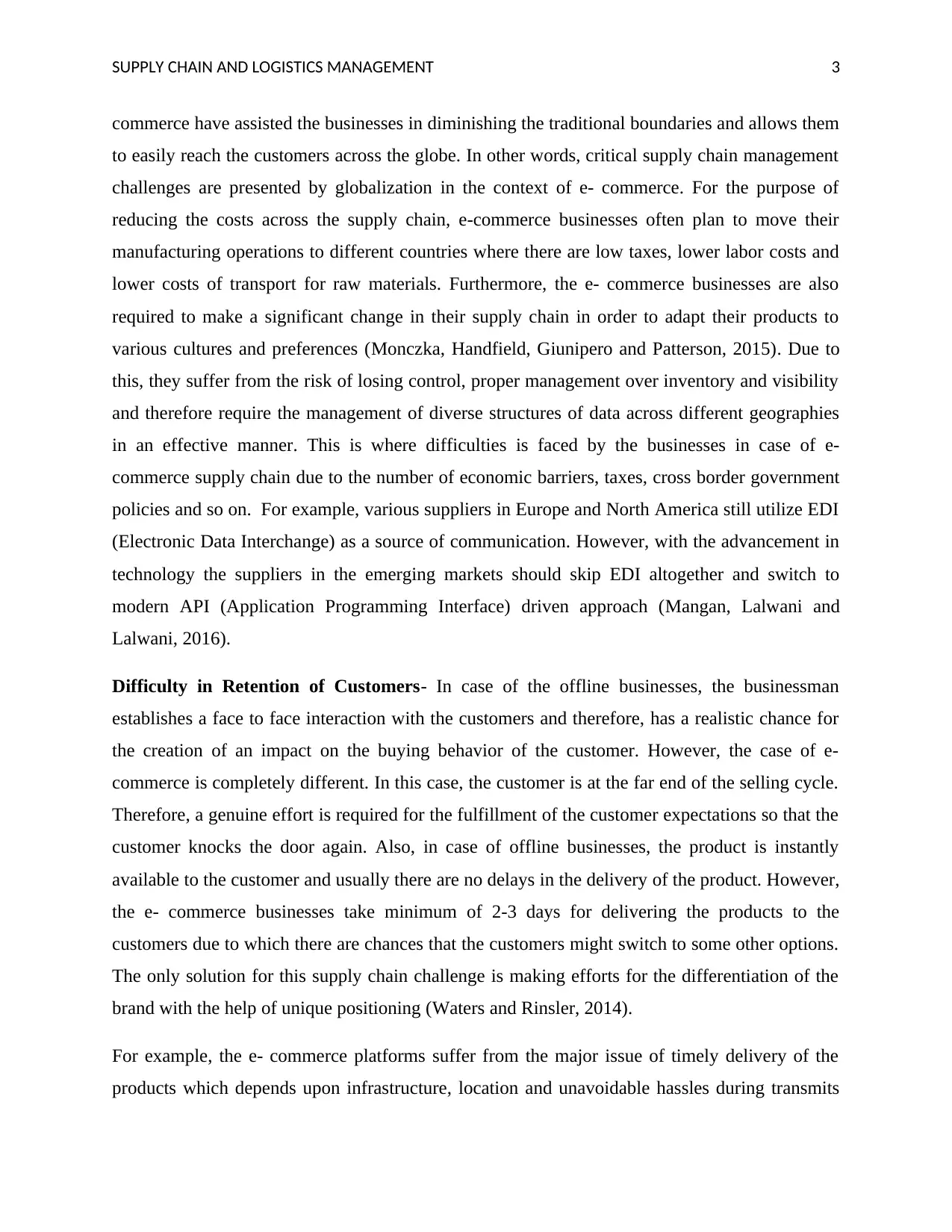
SUPPLY CHAIN AND LOGISTICS MANAGEMENT 3
commerce have assisted the businesses in diminishing the traditional boundaries and allows them
to easily reach the customers across the globe. In other words, critical supply chain management
challenges are presented by globalization in the context of e- commerce. For the purpose of
reducing the costs across the supply chain, e-commerce businesses often plan to move their
manufacturing operations to different countries where there are low taxes, lower labor costs and
lower costs of transport for raw materials. Furthermore, the e- commerce businesses are also
required to make a significant change in their supply chain in order to adapt their products to
various cultures and preferences (Monczka, Handfield, Giunipero and Patterson, 2015). Due to
this, they suffer from the risk of losing control, proper management over inventory and visibility
and therefore require the management of diverse structures of data across different geographies
in an effective manner. This is where difficulties is faced by the businesses in case of e-
commerce supply chain due to the number of economic barriers, taxes, cross border government
policies and so on. For example, various suppliers in Europe and North America still utilize EDI
(Electronic Data Interchange) as a source of communication. However, with the advancement in
technology the suppliers in the emerging markets should skip EDI altogether and switch to
modern API (Application Programming Interface) driven approach (Mangan, Lalwani and
Lalwani, 2016).
Difficulty in Retention of Customers- In case of the offline businesses, the businessman
establishes a face to face interaction with the customers and therefore, has a realistic chance for
the creation of an impact on the buying behavior of the customer. However, the case of e-
commerce is completely different. In this case, the customer is at the far end of the selling cycle.
Therefore, a genuine effort is required for the fulfillment of the customer expectations so that the
customer knocks the door again. Also, in case of offline businesses, the product is instantly
available to the customer and usually there are no delays in the delivery of the product. However,
the e- commerce businesses take minimum of 2-3 days for delivering the products to the
customers due to which there are chances that the customers might switch to some other options.
The only solution for this supply chain challenge is making efforts for the differentiation of the
brand with the help of unique positioning (Waters and Rinsler, 2014).
For example, the e- commerce platforms suffer from the major issue of timely delivery of the
products which depends upon infrastructure, location and unavoidable hassles during transmits
commerce have assisted the businesses in diminishing the traditional boundaries and allows them
to easily reach the customers across the globe. In other words, critical supply chain management
challenges are presented by globalization in the context of e- commerce. For the purpose of
reducing the costs across the supply chain, e-commerce businesses often plan to move their
manufacturing operations to different countries where there are low taxes, lower labor costs and
lower costs of transport for raw materials. Furthermore, the e- commerce businesses are also
required to make a significant change in their supply chain in order to adapt their products to
various cultures and preferences (Monczka, Handfield, Giunipero and Patterson, 2015). Due to
this, they suffer from the risk of losing control, proper management over inventory and visibility
and therefore require the management of diverse structures of data across different geographies
in an effective manner. This is where difficulties is faced by the businesses in case of e-
commerce supply chain due to the number of economic barriers, taxes, cross border government
policies and so on. For example, various suppliers in Europe and North America still utilize EDI
(Electronic Data Interchange) as a source of communication. However, with the advancement in
technology the suppliers in the emerging markets should skip EDI altogether and switch to
modern API (Application Programming Interface) driven approach (Mangan, Lalwani and
Lalwani, 2016).
Difficulty in Retention of Customers- In case of the offline businesses, the businessman
establishes a face to face interaction with the customers and therefore, has a realistic chance for
the creation of an impact on the buying behavior of the customer. However, the case of e-
commerce is completely different. In this case, the customer is at the far end of the selling cycle.
Therefore, a genuine effort is required for the fulfillment of the customer expectations so that the
customer knocks the door again. Also, in case of offline businesses, the product is instantly
available to the customer and usually there are no delays in the delivery of the product. However,
the e- commerce businesses take minimum of 2-3 days for delivering the products to the
customers due to which there are chances that the customers might switch to some other options.
The only solution for this supply chain challenge is making efforts for the differentiation of the
brand with the help of unique positioning (Waters and Rinsler, 2014).
For example, the e- commerce platforms suffer from the major issue of timely delivery of the
products which depends upon infrastructure, location and unavoidable hassles during transmits
Paraphrase This Document
Need a fresh take? Get an instant paraphrase of this document with our AI Paraphraser

SUPPLY CHAIN AND LOGISTICS MANAGEMENT 4
which often results in cancellation of the orders by the users due to non- delivery of the products
on time. This leads to difficulty in the retention of the customers by these platforms. Therefore,
best supply chain models are to be adopted by the e- commerce platforms by conducting R&D.
Fast-changing Markets- the behavior of the customers in the market is affected to a great extent
by various personal, social, cultural and psychological factors which are constantly being
changes due to globalization and technology. Social media is increasingly putting pressure on the
e-commerce businesses for utilizing the different sources of information for the purpose of
responding towards the changing preferences in order to stay relevant and interesting (Wisner,
Tan and Leong, 2014). This fast changing consumer market is also resulting in different supply
chain management challenges:
Firstly, the life cycle of the products is becoming shorter due to rapid changes taking place in the
market demand. The e- commerce businesses are under pressure to portray latest trends and
innovative products. Therefore, there is a demand for a flexible supply chain which can be
utilized for future projects and manufacturing of other products. Agile supply chain is also
required for responding well towards the demand and production requirements (Schönsleben,
2016).
For this purpose, the e- commerce companies should ask the suppliers regarding whether they
have the needed data for making the planning decisions so that the challenges created by the fast
changing markets can be duly addressed. For example, if more time is taken by the suppliers than
the stated lead time, higher inventory levels are required and the costly decisions around
optimization and network planning also get affected.
Talent- Another challenge faced by the supply chain management of the e- commerce
businesses is searching for the right talent for the fulfillment of the objectives of the business.
Right talent is the one which is qualified for meeting the requirement of the position. An
extensive understanding of the key duties and competencies is required by the supply chain
leaders of the e- commerce businesses for the effective regulation of the supply chain
management roles. They should also have the ability of efficiently sourcing the particular skill
sets and methods for the development of the future leaders. (Fredendall and Hill, 2016)
which often results in cancellation of the orders by the users due to non- delivery of the products
on time. This leads to difficulty in the retention of the customers by these platforms. Therefore,
best supply chain models are to be adopted by the e- commerce platforms by conducting R&D.
Fast-changing Markets- the behavior of the customers in the market is affected to a great extent
by various personal, social, cultural and psychological factors which are constantly being
changes due to globalization and technology. Social media is increasingly putting pressure on the
e-commerce businesses for utilizing the different sources of information for the purpose of
responding towards the changing preferences in order to stay relevant and interesting (Wisner,
Tan and Leong, 2014). This fast changing consumer market is also resulting in different supply
chain management challenges:
Firstly, the life cycle of the products is becoming shorter due to rapid changes taking place in the
market demand. The e- commerce businesses are under pressure to portray latest trends and
innovative products. Therefore, there is a demand for a flexible supply chain which can be
utilized for future projects and manufacturing of other products. Agile supply chain is also
required for responding well towards the demand and production requirements (Schönsleben,
2016).
For this purpose, the e- commerce companies should ask the suppliers regarding whether they
have the needed data for making the planning decisions so that the challenges created by the fast
changing markets can be duly addressed. For example, if more time is taken by the suppliers than
the stated lead time, higher inventory levels are required and the costly decisions around
optimization and network planning also get affected.
Talent- Another challenge faced by the supply chain management of the e- commerce
businesses is searching for the right talent for the fulfillment of the objectives of the business.
Right talent is the one which is qualified for meeting the requirement of the position. An
extensive understanding of the key duties and competencies is required by the supply chain
leaders of the e- commerce businesses for the effective regulation of the supply chain
management roles. They should also have the ability of efficiently sourcing the particular skill
sets and methods for the development of the future leaders. (Fredendall and Hill, 2016)
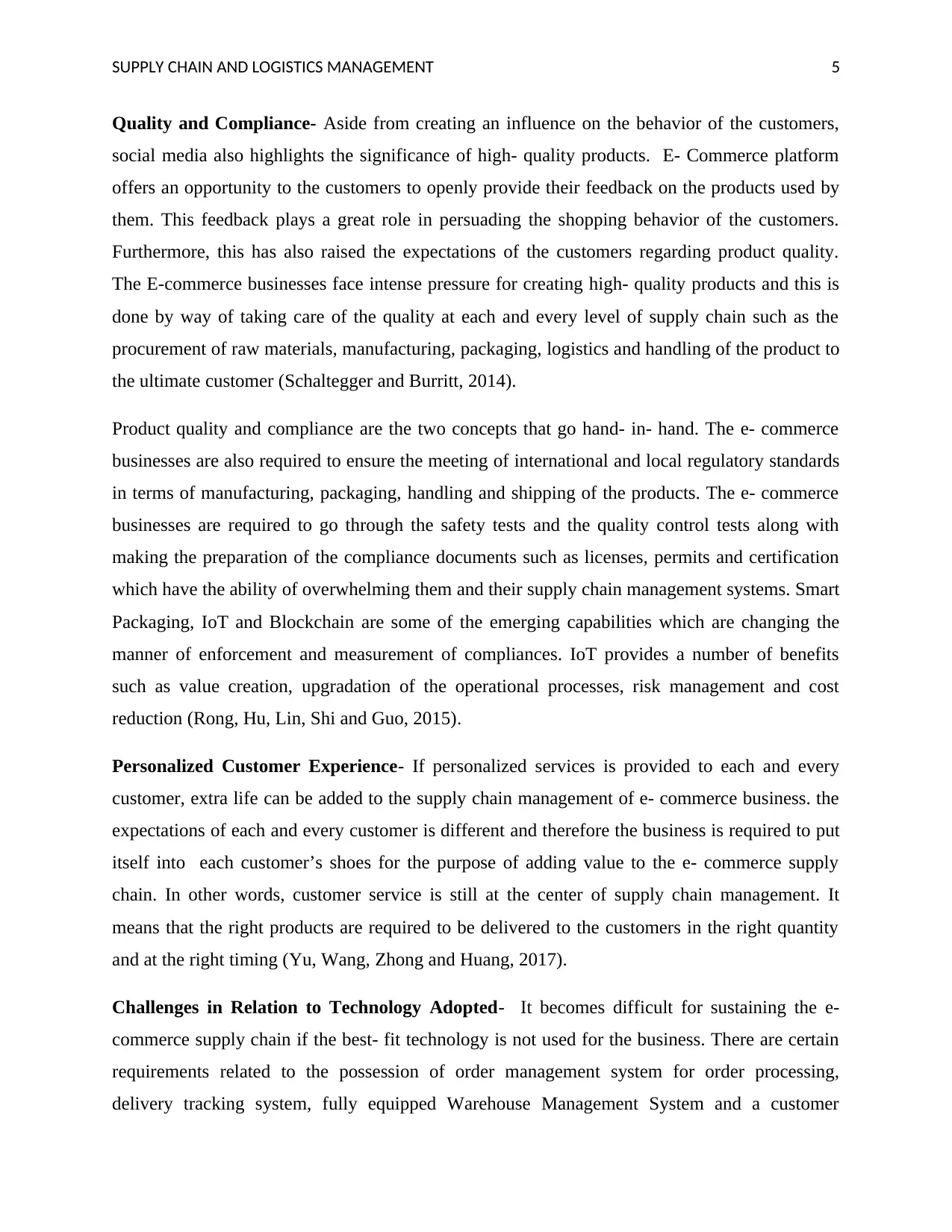
SUPPLY CHAIN AND LOGISTICS MANAGEMENT 5
Quality and Compliance- Aside from creating an influence on the behavior of the customers,
social media also highlights the significance of high- quality products. E- Commerce platform
offers an opportunity to the customers to openly provide their feedback on the products used by
them. This feedback plays a great role in persuading the shopping behavior of the customers.
Furthermore, this has also raised the expectations of the customers regarding product quality.
The E-commerce businesses face intense pressure for creating high- quality products and this is
done by way of taking care of the quality at each and every level of supply chain such as the
procurement of raw materials, manufacturing, packaging, logistics and handling of the product to
the ultimate customer (Schaltegger and Burritt, 2014).
Product quality and compliance are the two concepts that go hand- in- hand. The e- commerce
businesses are also required to ensure the meeting of international and local regulatory standards
in terms of manufacturing, packaging, handling and shipping of the products. The e- commerce
businesses are required to go through the safety tests and the quality control tests along with
making the preparation of the compliance documents such as licenses, permits and certification
which have the ability of overwhelming them and their supply chain management systems. Smart
Packaging, IoT and Blockchain are some of the emerging capabilities which are changing the
manner of enforcement and measurement of compliances. IoT provides a number of benefits
such as value creation, upgradation of the operational processes, risk management and cost
reduction (Rong, Hu, Lin, Shi and Guo, 2015).
Personalized Customer Experience- If personalized services is provided to each and every
customer, extra life can be added to the supply chain management of e- commerce business. the
expectations of each and every customer is different and therefore the business is required to put
itself into each customer’s shoes for the purpose of adding value to the e- commerce supply
chain. In other words, customer service is still at the center of supply chain management. It
means that the right products are required to be delivered to the customers in the right quantity
and at the right timing (Yu, Wang, Zhong and Huang, 2017).
Challenges in Relation to Technology Adopted- It becomes difficult for sustaining the e-
commerce supply chain if the best- fit technology is not used for the business. There are certain
requirements related to the possession of order management system for order processing,
delivery tracking system, fully equipped Warehouse Management System and a customer
Quality and Compliance- Aside from creating an influence on the behavior of the customers,
social media also highlights the significance of high- quality products. E- Commerce platform
offers an opportunity to the customers to openly provide their feedback on the products used by
them. This feedback plays a great role in persuading the shopping behavior of the customers.
Furthermore, this has also raised the expectations of the customers regarding product quality.
The E-commerce businesses face intense pressure for creating high- quality products and this is
done by way of taking care of the quality at each and every level of supply chain such as the
procurement of raw materials, manufacturing, packaging, logistics and handling of the product to
the ultimate customer (Schaltegger and Burritt, 2014).
Product quality and compliance are the two concepts that go hand- in- hand. The e- commerce
businesses are also required to ensure the meeting of international and local regulatory standards
in terms of manufacturing, packaging, handling and shipping of the products. The e- commerce
businesses are required to go through the safety tests and the quality control tests along with
making the preparation of the compliance documents such as licenses, permits and certification
which have the ability of overwhelming them and their supply chain management systems. Smart
Packaging, IoT and Blockchain are some of the emerging capabilities which are changing the
manner of enforcement and measurement of compliances. IoT provides a number of benefits
such as value creation, upgradation of the operational processes, risk management and cost
reduction (Rong, Hu, Lin, Shi and Guo, 2015).
Personalized Customer Experience- If personalized services is provided to each and every
customer, extra life can be added to the supply chain management of e- commerce business. the
expectations of each and every customer is different and therefore the business is required to put
itself into each customer’s shoes for the purpose of adding value to the e- commerce supply
chain. In other words, customer service is still at the center of supply chain management. It
means that the right products are required to be delivered to the customers in the right quantity
and at the right timing (Yu, Wang, Zhong and Huang, 2017).
Challenges in Relation to Technology Adopted- It becomes difficult for sustaining the e-
commerce supply chain if the best- fit technology is not used for the business. There are certain
requirements related to the possession of order management system for order processing,
delivery tracking system, fully equipped Warehouse Management System and a customer
⊘ This is a preview!⊘
Do you want full access?
Subscribe today to unlock all pages.

Trusted by 1+ million students worldwide
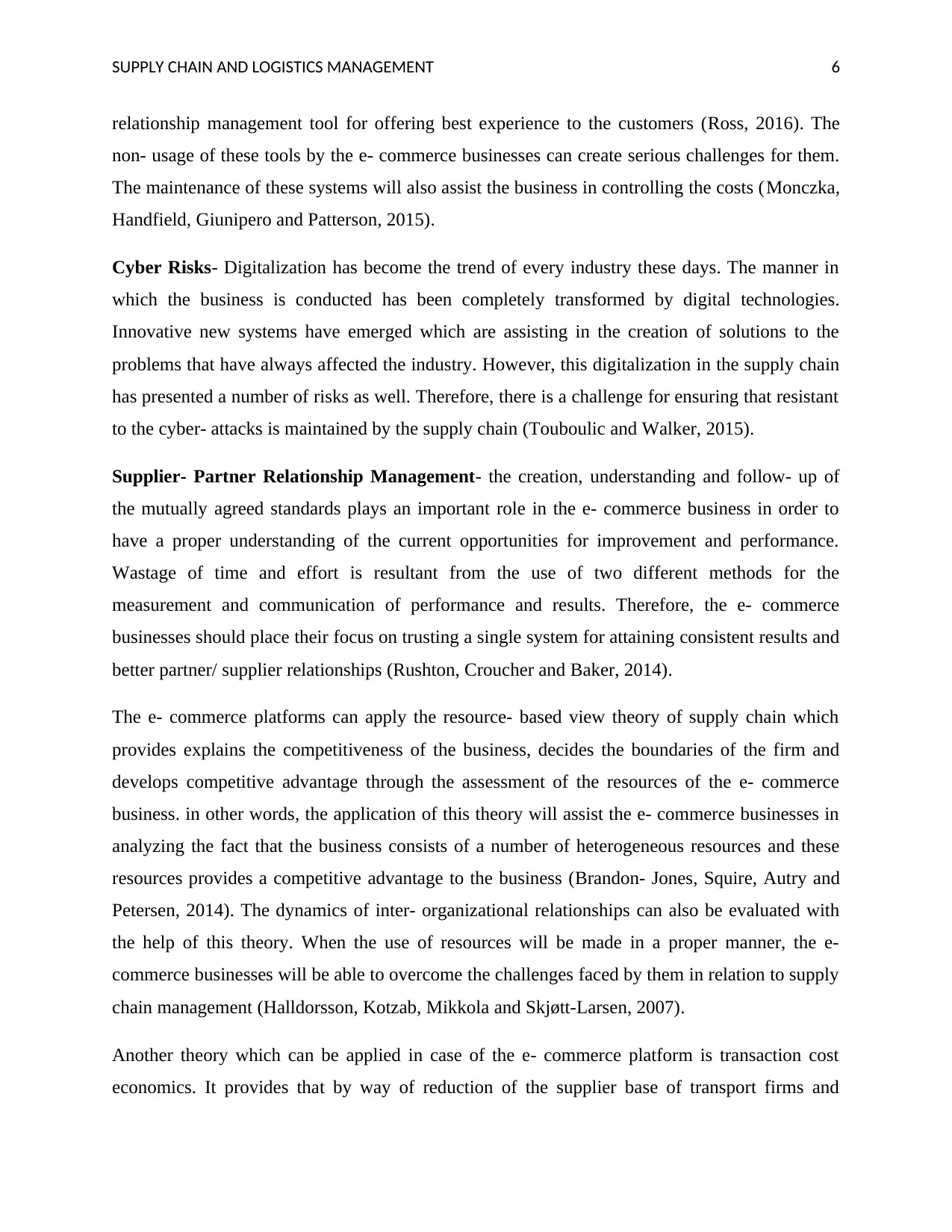
SUPPLY CHAIN AND LOGISTICS MANAGEMENT 6
relationship management tool for offering best experience to the customers (Ross, 2016). The
non- usage of these tools by the e- commerce businesses can create serious challenges for them.
The maintenance of these systems will also assist the business in controlling the costs (Monczka,
Handfield, Giunipero and Patterson, 2015).
Cyber Risks- Digitalization has become the trend of every industry these days. The manner in
which the business is conducted has been completely transformed by digital technologies.
Innovative new systems have emerged which are assisting in the creation of solutions to the
problems that have always affected the industry. However, this digitalization in the supply chain
has presented a number of risks as well. Therefore, there is a challenge for ensuring that resistant
to the cyber- attacks is maintained by the supply chain (Touboulic and Walker, 2015).
Supplier- Partner Relationship Management- the creation, understanding and follow- up of
the mutually agreed standards plays an important role in the e- commerce business in order to
have a proper understanding of the current opportunities for improvement and performance.
Wastage of time and effort is resultant from the use of two different methods for the
measurement and communication of performance and results. Therefore, the e- commerce
businesses should place their focus on trusting a single system for attaining consistent results and
better partner/ supplier relationships (Rushton, Croucher and Baker, 2014).
The e- commerce platforms can apply the resource- based view theory of supply chain which
provides explains the competitiveness of the business, decides the boundaries of the firm and
develops competitive advantage through the assessment of the resources of the e- commerce
business. in other words, the application of this theory will assist the e- commerce businesses in
analyzing the fact that the business consists of a number of heterogeneous resources and these
resources provides a competitive advantage to the business (Brandon‐ Jones, Squire, Autry and
Petersen, 2014). The dynamics of inter- organizational relationships can also be evaluated with
the help of this theory. When the use of resources will be made in a proper manner, the e-
commerce businesses will be able to overcome the challenges faced by them in relation to supply
chain management (Halldorsson, Kotzab, Mikkola and Skjøtt-Larsen, 2007).
Another theory which can be applied in case of the e- commerce platform is transaction cost
economics. It provides that by way of reduction of the supplier base of transport firms and
relationship management tool for offering best experience to the customers (Ross, 2016). The
non- usage of these tools by the e- commerce businesses can create serious challenges for them.
The maintenance of these systems will also assist the business in controlling the costs (Monczka,
Handfield, Giunipero and Patterson, 2015).
Cyber Risks- Digitalization has become the trend of every industry these days. The manner in
which the business is conducted has been completely transformed by digital technologies.
Innovative new systems have emerged which are assisting in the creation of solutions to the
problems that have always affected the industry. However, this digitalization in the supply chain
has presented a number of risks as well. Therefore, there is a challenge for ensuring that resistant
to the cyber- attacks is maintained by the supply chain (Touboulic and Walker, 2015).
Supplier- Partner Relationship Management- the creation, understanding and follow- up of
the mutually agreed standards plays an important role in the e- commerce business in order to
have a proper understanding of the current opportunities for improvement and performance.
Wastage of time and effort is resultant from the use of two different methods for the
measurement and communication of performance and results. Therefore, the e- commerce
businesses should place their focus on trusting a single system for attaining consistent results and
better partner/ supplier relationships (Rushton, Croucher and Baker, 2014).
The e- commerce platforms can apply the resource- based view theory of supply chain which
provides explains the competitiveness of the business, decides the boundaries of the firm and
develops competitive advantage through the assessment of the resources of the e- commerce
business. in other words, the application of this theory will assist the e- commerce businesses in
analyzing the fact that the business consists of a number of heterogeneous resources and these
resources provides a competitive advantage to the business (Brandon‐ Jones, Squire, Autry and
Petersen, 2014). The dynamics of inter- organizational relationships can also be evaluated with
the help of this theory. When the use of resources will be made in a proper manner, the e-
commerce businesses will be able to overcome the challenges faced by them in relation to supply
chain management (Halldorsson, Kotzab, Mikkola and Skjøtt-Larsen, 2007).
Another theory which can be applied in case of the e- commerce platform is transaction cost
economics. It provides that by way of reduction of the supplier base of transport firms and
Paraphrase This Document
Need a fresh take? Get an instant paraphrase of this document with our AI Paraphraser

SUPPLY CHAIN AND LOGISTICS MANAGEMENT 7
entering into long germ and close cooperation with the key operators, the transaction costs of the
firms can be reduced. This transaction cost is associated with the collection of information from
various suppliers, costs of negotiation and writing a contract along with the enforcement costs
after negotiation. The role of logistics is crucial in supply chain management (Sadler, 2007).
Moreover, in case of e- commerce, the on- time delivery of the products to the customers is
ensured by logistics. The transaction costs can be divided into enforcement costs, information
costs and bargaining costs. The proper division of the transaction costs can assist the e-
commerce platforms in meeting the challenges of supply chain management such as inventory
visibility, channel specific processes and speed of delivery (Short, Toffel and Hugill, 2016).
Solutions to the Supply Chain Management Challenges in the Context of E- Commerce
Since a number of challenges are faced by the e- commerce businesses in the supply chain
management, there are also a number of possible solutions which can be adopted for the purpose
of overcoming these challenges. Following are some of the solutions to supply chain
management challenges.
Data Integration and Data Management- Data management and data integration can be of
great help for the purpose of overcoming the supply chain management challenges in the context
of e- commerce. In other words, at the core of these challenges, there is a requirement for better
data integration and data management (Christopher, Harrison and van Hoek, 2016). E-
commerce businesses faces challenges in respect of market expansions, global operations and
stricter regulatory and quality standards and therefore are overwhelmed by bulk of information
coming from different customers and suppliers in various geographic location which is required
to be managed. This includes data and information from different stages of supply chain such as
labor agreements, materials (direct and indirect) , freight bills, rental contracts, tax related
documents, compliance certificates, etc. Data management and integration can be regarded as the
key for resolving the challenges by way of establishing a connection between the supply chain
management systems of the e- commerce business and their partners and suppliers. The e-
commerce businesses are in a better position to have control and visibility over the supply chain
processes like procuring, manufacturing, warehousing and logistics with the help of data
management and integration. Both structured and unstructured data is contained in the raw
entering into long germ and close cooperation with the key operators, the transaction costs of the
firms can be reduced. This transaction cost is associated with the collection of information from
various suppliers, costs of negotiation and writing a contract along with the enforcement costs
after negotiation. The role of logistics is crucial in supply chain management (Sadler, 2007).
Moreover, in case of e- commerce, the on- time delivery of the products to the customers is
ensured by logistics. The transaction costs can be divided into enforcement costs, information
costs and bargaining costs. The proper division of the transaction costs can assist the e-
commerce platforms in meeting the challenges of supply chain management such as inventory
visibility, channel specific processes and speed of delivery (Short, Toffel and Hugill, 2016).
Solutions to the Supply Chain Management Challenges in the Context of E- Commerce
Since a number of challenges are faced by the e- commerce businesses in the supply chain
management, there are also a number of possible solutions which can be adopted for the purpose
of overcoming these challenges. Following are some of the solutions to supply chain
management challenges.
Data Integration and Data Management- Data management and data integration can be of
great help for the purpose of overcoming the supply chain management challenges in the context
of e- commerce. In other words, at the core of these challenges, there is a requirement for better
data integration and data management (Christopher, Harrison and van Hoek, 2016). E-
commerce businesses faces challenges in respect of market expansions, global operations and
stricter regulatory and quality standards and therefore are overwhelmed by bulk of information
coming from different customers and suppliers in various geographic location which is required
to be managed. This includes data and information from different stages of supply chain such as
labor agreements, materials (direct and indirect) , freight bills, rental contracts, tax related
documents, compliance certificates, etc. Data management and integration can be regarded as the
key for resolving the challenges by way of establishing a connection between the supply chain
management systems of the e- commerce business and their partners and suppliers. The e-
commerce businesses are in a better position to have control and visibility over the supply chain
processes like procuring, manufacturing, warehousing and logistics with the help of data
management and integration. Both structured and unstructured data is contained in the raw
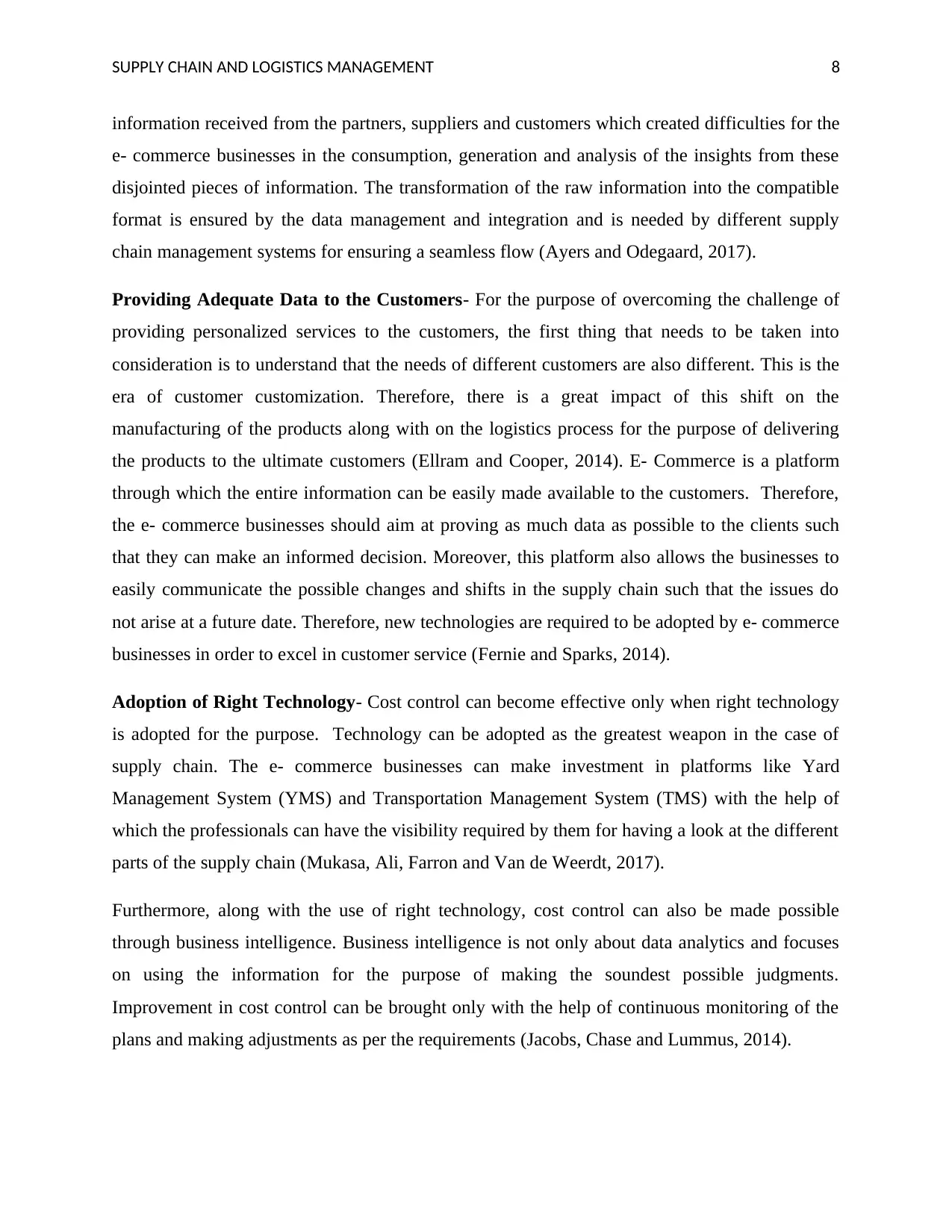
SUPPLY CHAIN AND LOGISTICS MANAGEMENT 8
information received from the partners, suppliers and customers which created difficulties for the
e- commerce businesses in the consumption, generation and analysis of the insights from these
disjointed pieces of information. The transformation of the raw information into the compatible
format is ensured by the data management and integration and is needed by different supply
chain management systems for ensuring a seamless flow (Ayers and Odegaard, 2017).
Providing Adequate Data to the Customers- For the purpose of overcoming the challenge of
providing personalized services to the customers, the first thing that needs to be taken into
consideration is to understand that the needs of different customers are also different. This is the
era of customer customization. Therefore, there is a great impact of this shift on the
manufacturing of the products along with on the logistics process for the purpose of delivering
the products to the ultimate customers (Ellram and Cooper, 2014). E- Commerce is a platform
through which the entire information can be easily made available to the customers. Therefore,
the e- commerce businesses should aim at proving as much data as possible to the clients such
that they can make an informed decision. Moreover, this platform also allows the businesses to
easily communicate the possible changes and shifts in the supply chain such that the issues do
not arise at a future date. Therefore, new technologies are required to be adopted by e- commerce
businesses in order to excel in customer service (Fernie and Sparks, 2014).
Adoption of Right Technology- Cost control can become effective only when right technology
is adopted for the purpose. Technology can be adopted as the greatest weapon in the case of
supply chain. The e- commerce businesses can make investment in platforms like Yard
Management System (YMS) and Transportation Management System (TMS) with the help of
which the professionals can have the visibility required by them for having a look at the different
parts of the supply chain (Mukasa, Ali, Farron and Van de Weerdt, 2017).
Furthermore, along with the use of right technology, cost control can also be made possible
through business intelligence. Business intelligence is not only about data analytics and focuses
on using the information for the purpose of making the soundest possible judgments.
Improvement in cost control can be brought only with the help of continuous monitoring of the
plans and making adjustments as per the requirements (Jacobs, Chase and Lummus, 2014).
information received from the partners, suppliers and customers which created difficulties for the
e- commerce businesses in the consumption, generation and analysis of the insights from these
disjointed pieces of information. The transformation of the raw information into the compatible
format is ensured by the data management and integration and is needed by different supply
chain management systems for ensuring a seamless flow (Ayers and Odegaard, 2017).
Providing Adequate Data to the Customers- For the purpose of overcoming the challenge of
providing personalized services to the customers, the first thing that needs to be taken into
consideration is to understand that the needs of different customers are also different. This is the
era of customer customization. Therefore, there is a great impact of this shift on the
manufacturing of the products along with on the logistics process for the purpose of delivering
the products to the ultimate customers (Ellram and Cooper, 2014). E- Commerce is a platform
through which the entire information can be easily made available to the customers. Therefore,
the e- commerce businesses should aim at proving as much data as possible to the clients such
that they can make an informed decision. Moreover, this platform also allows the businesses to
easily communicate the possible changes and shifts in the supply chain such that the issues do
not arise at a future date. Therefore, new technologies are required to be adopted by e- commerce
businesses in order to excel in customer service (Fernie and Sparks, 2014).
Adoption of Right Technology- Cost control can become effective only when right technology
is adopted for the purpose. Technology can be adopted as the greatest weapon in the case of
supply chain. The e- commerce businesses can make investment in platforms like Yard
Management System (YMS) and Transportation Management System (TMS) with the help of
which the professionals can have the visibility required by them for having a look at the different
parts of the supply chain (Mukasa, Ali, Farron and Van de Weerdt, 2017).
Furthermore, along with the use of right technology, cost control can also be made possible
through business intelligence. Business intelligence is not only about data analytics and focuses
on using the information for the purpose of making the soundest possible judgments.
Improvement in cost control can be brought only with the help of continuous monitoring of the
plans and making adjustments as per the requirements (Jacobs, Chase and Lummus, 2014).
⊘ This is a preview!⊘
Do you want full access?
Subscribe today to unlock all pages.

Trusted by 1+ million students worldwide
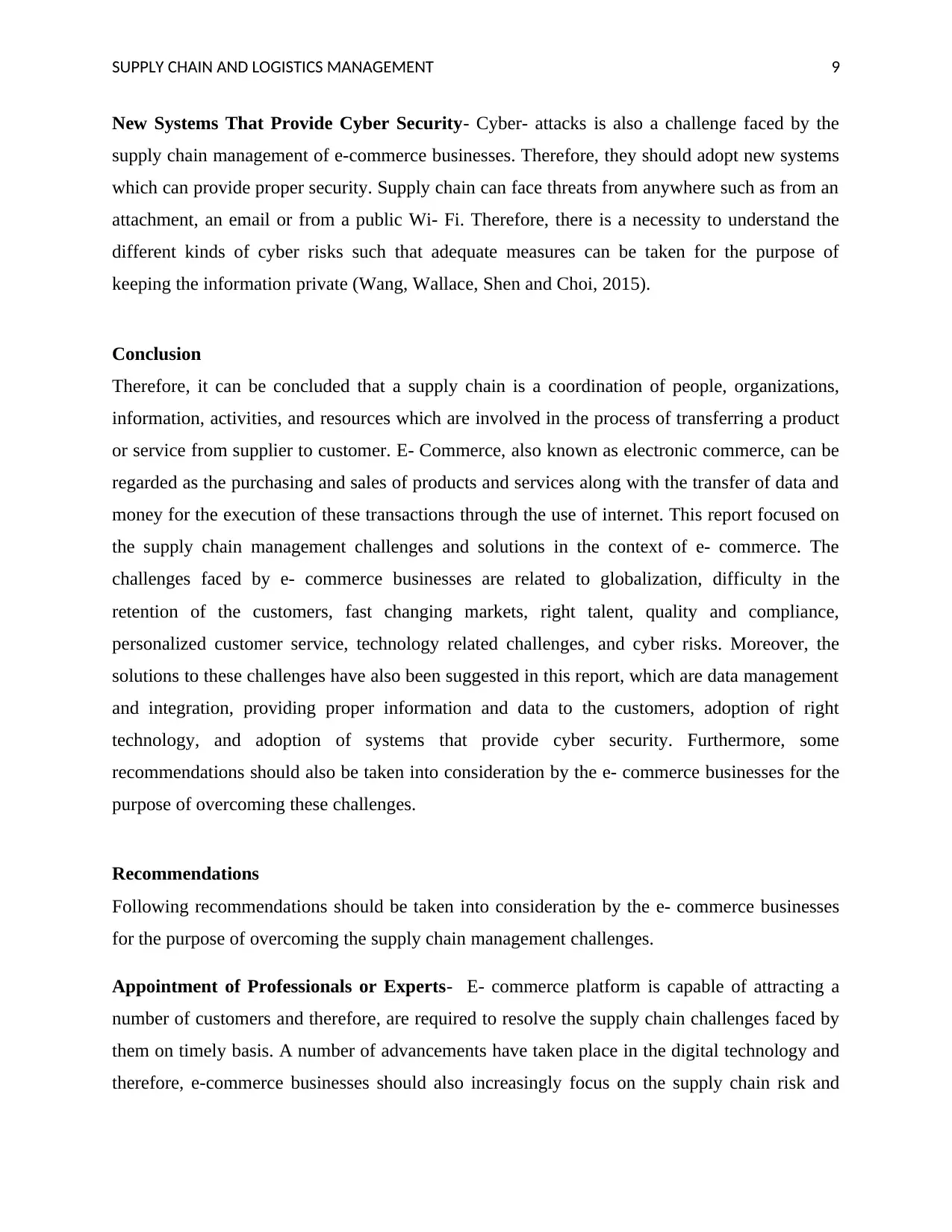
SUPPLY CHAIN AND LOGISTICS MANAGEMENT 9
New Systems That Provide Cyber Security- Cyber- attacks is also a challenge faced by the
supply chain management of e-commerce businesses. Therefore, they should adopt new systems
which can provide proper security. Supply chain can face threats from anywhere such as from an
attachment, an email or from a public Wi- Fi. Therefore, there is a necessity to understand the
different kinds of cyber risks such that adequate measures can be taken for the purpose of
keeping the information private (Wang, Wallace, Shen and Choi, 2015).
Conclusion
Therefore, it can be concluded that a supply chain is a coordination of people, organizations,
information, activities, and resources which are involved in the process of transferring a product
or service from supplier to customer. E- Commerce, also known as electronic commerce, can be
regarded as the purchasing and sales of products and services along with the transfer of data and
money for the execution of these transactions through the use of internet. This report focused on
the supply chain management challenges and solutions in the context of e- commerce. The
challenges faced by e- commerce businesses are related to globalization, difficulty in the
retention of the customers, fast changing markets, right talent, quality and compliance,
personalized customer service, technology related challenges, and cyber risks. Moreover, the
solutions to these challenges have also been suggested in this report, which are data management
and integration, providing proper information and data to the customers, adoption of right
technology, and adoption of systems that provide cyber security. Furthermore, some
recommendations should also be taken into consideration by the e- commerce businesses for the
purpose of overcoming these challenges.
Recommendations
Following recommendations should be taken into consideration by the e- commerce businesses
for the purpose of overcoming the supply chain management challenges.
Appointment of Professionals or Experts- E- commerce platform is capable of attracting a
number of customers and therefore, are required to resolve the supply chain challenges faced by
them on timely basis. A number of advancements have taken place in the digital technology and
therefore, e-commerce businesses should also increasingly focus on the supply chain risk and
New Systems That Provide Cyber Security- Cyber- attacks is also a challenge faced by the
supply chain management of e-commerce businesses. Therefore, they should adopt new systems
which can provide proper security. Supply chain can face threats from anywhere such as from an
attachment, an email or from a public Wi- Fi. Therefore, there is a necessity to understand the
different kinds of cyber risks such that adequate measures can be taken for the purpose of
keeping the information private (Wang, Wallace, Shen and Choi, 2015).
Conclusion
Therefore, it can be concluded that a supply chain is a coordination of people, organizations,
information, activities, and resources which are involved in the process of transferring a product
or service from supplier to customer. E- Commerce, also known as electronic commerce, can be
regarded as the purchasing and sales of products and services along with the transfer of data and
money for the execution of these transactions through the use of internet. This report focused on
the supply chain management challenges and solutions in the context of e- commerce. The
challenges faced by e- commerce businesses are related to globalization, difficulty in the
retention of the customers, fast changing markets, right talent, quality and compliance,
personalized customer service, technology related challenges, and cyber risks. Moreover, the
solutions to these challenges have also been suggested in this report, which are data management
and integration, providing proper information and data to the customers, adoption of right
technology, and adoption of systems that provide cyber security. Furthermore, some
recommendations should also be taken into consideration by the e- commerce businesses for the
purpose of overcoming these challenges.
Recommendations
Following recommendations should be taken into consideration by the e- commerce businesses
for the purpose of overcoming the supply chain management challenges.
Appointment of Professionals or Experts- E- commerce platform is capable of attracting a
number of customers and therefore, are required to resolve the supply chain challenges faced by
them on timely basis. A number of advancements have taken place in the digital technology and
therefore, e-commerce businesses should also increasingly focus on the supply chain risk and
Paraphrase This Document
Need a fresh take? Get an instant paraphrase of this document with our AI Paraphraser
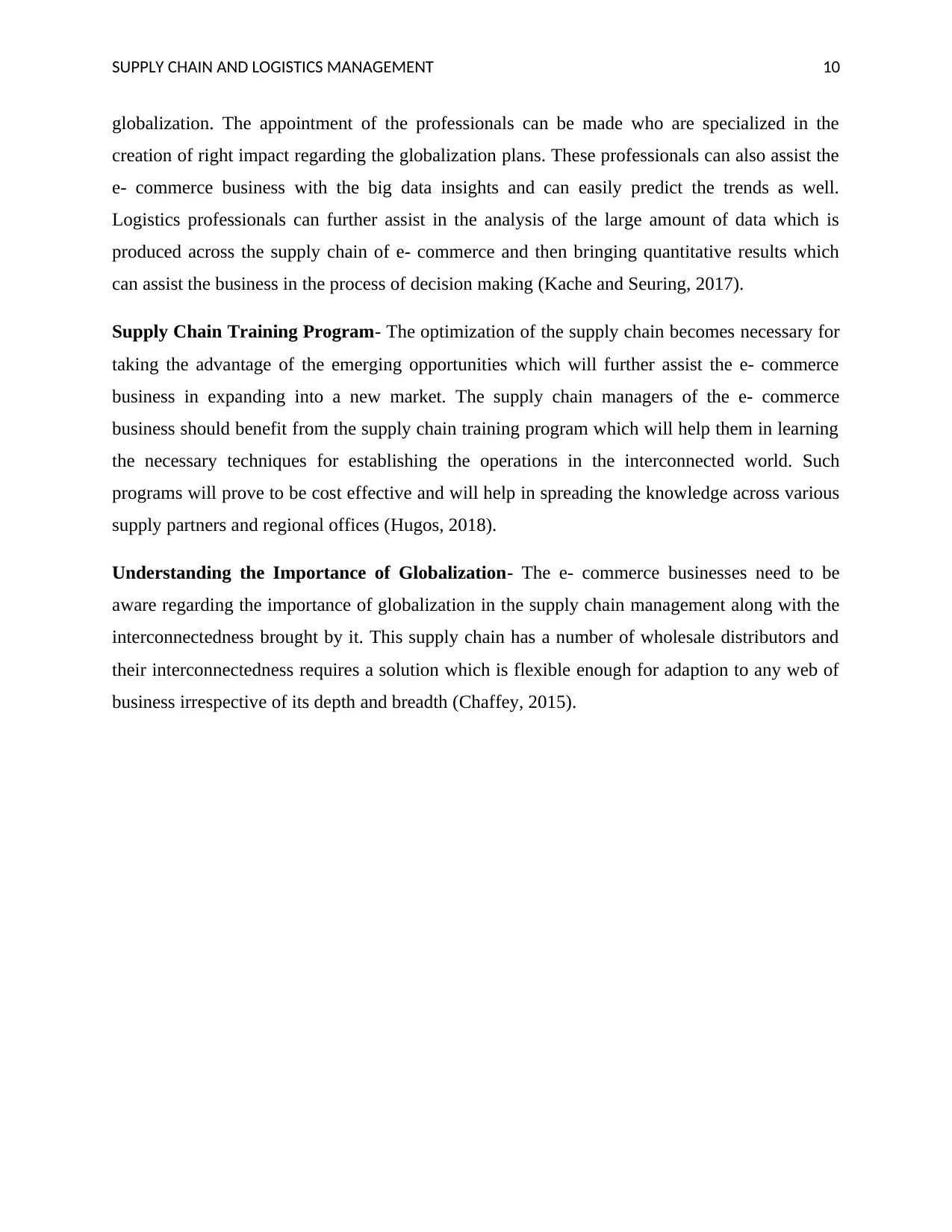
SUPPLY CHAIN AND LOGISTICS MANAGEMENT 10
globalization. The appointment of the professionals can be made who are specialized in the
creation of right impact regarding the globalization plans. These professionals can also assist the
e- commerce business with the big data insights and can easily predict the trends as well.
Logistics professionals can further assist in the analysis of the large amount of data which is
produced across the supply chain of e- commerce and then bringing quantitative results which
can assist the business in the process of decision making (Kache and Seuring, 2017).
Supply Chain Training Program- The optimization of the supply chain becomes necessary for
taking the advantage of the emerging opportunities which will further assist the e- commerce
business in expanding into a new market. The supply chain managers of the e- commerce
business should benefit from the supply chain training program which will help them in learning
the necessary techniques for establishing the operations in the interconnected world. Such
programs will prove to be cost effective and will help in spreading the knowledge across various
supply partners and regional offices (Hugos, 2018).
Understanding the Importance of Globalization- The e- commerce businesses need to be
aware regarding the importance of globalization in the supply chain management along with the
interconnectedness brought by it. This supply chain has a number of wholesale distributors and
their interconnectedness requires a solution which is flexible enough for adaption to any web of
business irrespective of its depth and breadth (Chaffey, 2015).
globalization. The appointment of the professionals can be made who are specialized in the
creation of right impact regarding the globalization plans. These professionals can also assist the
e- commerce business with the big data insights and can easily predict the trends as well.
Logistics professionals can further assist in the analysis of the large amount of data which is
produced across the supply chain of e- commerce and then bringing quantitative results which
can assist the business in the process of decision making (Kache and Seuring, 2017).
Supply Chain Training Program- The optimization of the supply chain becomes necessary for
taking the advantage of the emerging opportunities which will further assist the e- commerce
business in expanding into a new market. The supply chain managers of the e- commerce
business should benefit from the supply chain training program which will help them in learning
the necessary techniques for establishing the operations in the interconnected world. Such
programs will prove to be cost effective and will help in spreading the knowledge across various
supply partners and regional offices (Hugos, 2018).
Understanding the Importance of Globalization- The e- commerce businesses need to be
aware regarding the importance of globalization in the supply chain management along with the
interconnectedness brought by it. This supply chain has a number of wholesale distributors and
their interconnectedness requires a solution which is flexible enough for adaption to any web of
business irrespective of its depth and breadth (Chaffey, 2015).

SUPPLY CHAIN AND LOGISTICS MANAGEMENT 11
References
Ayers, J.B. and Odegaard, M.A., 2017. Retail supply chain management. CRC Press.
Brandon‐ Jones, E., Squire, B., Autry, C.W. and Petersen, K.J., 2014. A contingent resource‐
based perspective of supply chain resilience and robustness. Journal of Supply Chain
Management, 50(3), pp.55-73.
Chaffey, D., 2015. Digital business and e-commerce management. Pearson Education Limited.
Christopher, M., 2016. Logistics & supply chain management. Pearson UK.
Christopher, M., Harrison, A. and van Hoek, R., 2016. Creating the agile supply chain: issues
and challenges. In Developments in logistics and supply chain management (pp. 61-68). Palgrave
Macmillan, London.
Ellram, L.M. and Cooper, M.C., 2014. Supply chain management: It's all about the journey, not
the destination. Journal of Supply Chain Management, 50(1), pp.8-20.
Fernie, J. and Sparks, L., 2014. Logistics and retail management: emerging issues and new
challenges in the retail supply chain. Kogan page publishers.
Fredendall, L.D. and Hill, E., 2016. Basics of supply chain management. CRC Press.
Halldorsson, A., Kotzab, H., Mikkola, J.H. and Skjøtt-Larsen, T., 2007. Complementary theories
to supply chain management. Supply chain management: An international journal, 12(4),
pp.284-296.
Hugos, M.H., 2018. Essentials of supply chain management. John Wiley & Sons.
Jacobs, F.R., Chase, R.B. and Lummus, R.R., 2014. Operations and supply chain
management (pp. 533-535). New York, NY: McGraw-Hill/Irwin.
Kache, F. and Seuring, S., 2017. Challenges and opportunities of digital information at the
intersection of Big Data Analytics and supply chain management. International Journal of
Operations & Production Management, 37(1), pp.10-36.
References
Ayers, J.B. and Odegaard, M.A., 2017. Retail supply chain management. CRC Press.
Brandon‐ Jones, E., Squire, B., Autry, C.W. and Petersen, K.J., 2014. A contingent resource‐
based perspective of supply chain resilience and robustness. Journal of Supply Chain
Management, 50(3), pp.55-73.
Chaffey, D., 2015. Digital business and e-commerce management. Pearson Education Limited.
Christopher, M., 2016. Logistics & supply chain management. Pearson UK.
Christopher, M., Harrison, A. and van Hoek, R., 2016. Creating the agile supply chain: issues
and challenges. In Developments in logistics and supply chain management (pp. 61-68). Palgrave
Macmillan, London.
Ellram, L.M. and Cooper, M.C., 2014. Supply chain management: It's all about the journey, not
the destination. Journal of Supply Chain Management, 50(1), pp.8-20.
Fernie, J. and Sparks, L., 2014. Logistics and retail management: emerging issues and new
challenges in the retail supply chain. Kogan page publishers.
Fredendall, L.D. and Hill, E., 2016. Basics of supply chain management. CRC Press.
Halldorsson, A., Kotzab, H., Mikkola, J.H. and Skjøtt-Larsen, T., 2007. Complementary theories
to supply chain management. Supply chain management: An international journal, 12(4),
pp.284-296.
Hugos, M.H., 2018. Essentials of supply chain management. John Wiley & Sons.
Jacobs, F.R., Chase, R.B. and Lummus, R.R., 2014. Operations and supply chain
management (pp. 533-535). New York, NY: McGraw-Hill/Irwin.
Kache, F. and Seuring, S., 2017. Challenges and opportunities of digital information at the
intersection of Big Data Analytics and supply chain management. International Journal of
Operations & Production Management, 37(1), pp.10-36.
⊘ This is a preview!⊘
Do you want full access?
Subscribe today to unlock all pages.

Trusted by 1+ million students worldwide
1 out of 14
Related Documents
Your All-in-One AI-Powered Toolkit for Academic Success.
+13062052269
info@desklib.com
Available 24*7 on WhatsApp / Email
![[object Object]](/_next/static/media/star-bottom.7253800d.svg)
Unlock your academic potential
Copyright © 2020–2025 A2Z Services. All Rights Reserved. Developed and managed by ZUCOL.



